Straightforward and efficient project communication management is a must for any software development project, as it is essential for making progress, discovering issues, and delivering a quality product on time. Building and managing project communication is a big part of a project manager’s (PM’s) job. The PM ensures that the project team and stakeholders are on the same page about the project’s progress, tasks, and current objectives.
In this article, we discuss the importance of project communication management and share how Apriorit organizes in-project communication that is convenient for both our team and the client. We analyze two important communication tools — reports and meetings — and provide practical advice for improving in-project communication with their help.
This article will be useful for organizations that want to ensure efficient communication within their development teams, especially when working with outsourcing companies.
Why is project communication management important?
In software development, efficient communication is one of the key success factors for any project. Building and managing communications is an important part of any project manager’s work.
The Project Management Body of Knowledge (PMBOK) defines project communication management as the “processes required to ensure timely and appropriate generation, collection, dissemination, storage, and ultimate disposition of project information.”
These processes help a PM define and build communication between all project participants that facilitates results, ensures flexibility, and allows team members to make adjustments at any stage. The PM has to understand who in the communication process should receive what information, when and in what form this information should be provided, and what communication factors must be taken into account (languages, time zones, working hours, technologies, cultural differences).
Investing your time in communication management and project management helps to achieve these goals:

- Shared understanding of project goals and processes. Clear and efficient communication allows the team to share information, ideas, and opinions. It helps the team understand the client’s needs and expectations, as well as each other’s intentions.
- Delivering results within established project deadlines. From the start of the project, all participants should understand their influence on the results, as well as the project’s purpose and restrictions. Communicating with each other helps team members organize their work and ensure delivery within deadlines.
- Efficient problem-solving. Properly built communication between the client and the development team helps to quickly solve all current issues or conflicts without creating obstacles to overall project progress. The PM also facilitates problem-solving as a neutral person who seeks a way to use the team’s expertise to find a solution for an issue and to keep the client satisfied with the project’s results.
- Increased client trust in the team. Clear communication of the project goals, current status, and team plans helps a client understand what’s happening inside their project and gain trust in the development team. In turn, this trust makes it possible to create a positive environment in which each project participant feels valued and important to the project’s success.
- Continuous improvement of project processes. Effective project communication stimulates all participants to exchange new ideas and knowledge and inspires searching for new possibilities, non-standard approaches, and creative and technical solutions to improve product performance and the development process.
The best way to ensure efficient project communication management depends on the goal: establishing understanding within the project team, reporting to the client, or keeping all project stakeholders on the same page. Based on the goal, our project managers choose corresponding communication tools, such as meetings and reports. The PM also adjusts these tools based on factors like the size of the team and team members’ locations, time zones, languages, etc.
Let’s examine how meetings and reports help our project managers establish straightforward project communication and facilitate the project’s progress.
Have a complicated project in mind?
Reach out to see how our PMs can help you build efficient project processes and deliver your dream product within your budget and deadlines.
Key meetings in project communication management
During any meeting, a project manager has to be actively present to notice details, changes, and possible risks before they become critical. If a manager sees that a team member has some issues, they should immediately check what is going on, eliminate blockers, and help the team member get back on track. For example, if a developer needs additional tools or knowledge, their PM has to figure out ways to get the needed information, devices, resources, etc.
When holding any meeting, Apriorit PMs always follow Project Management Institute (PMI) recommendations:
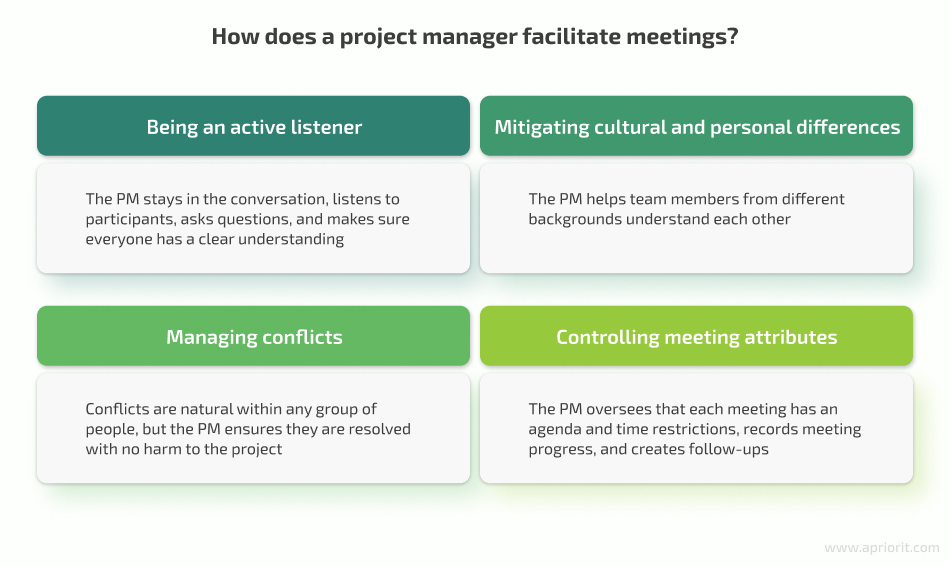
Let’s take a closer look at typical meetings that we include in our project communication management plan and their purposes.
Daily stand-up
Daily stand-up meetings, also known as daily meetings, are a common practice in Agile project management. Daily stand-up meetings typically last around 15 minutes, although they may be longer for teams of eight or more. If a project team consists of several people and they have long-term tasks, a PM can conduct stand-up meetings two or three times a week.
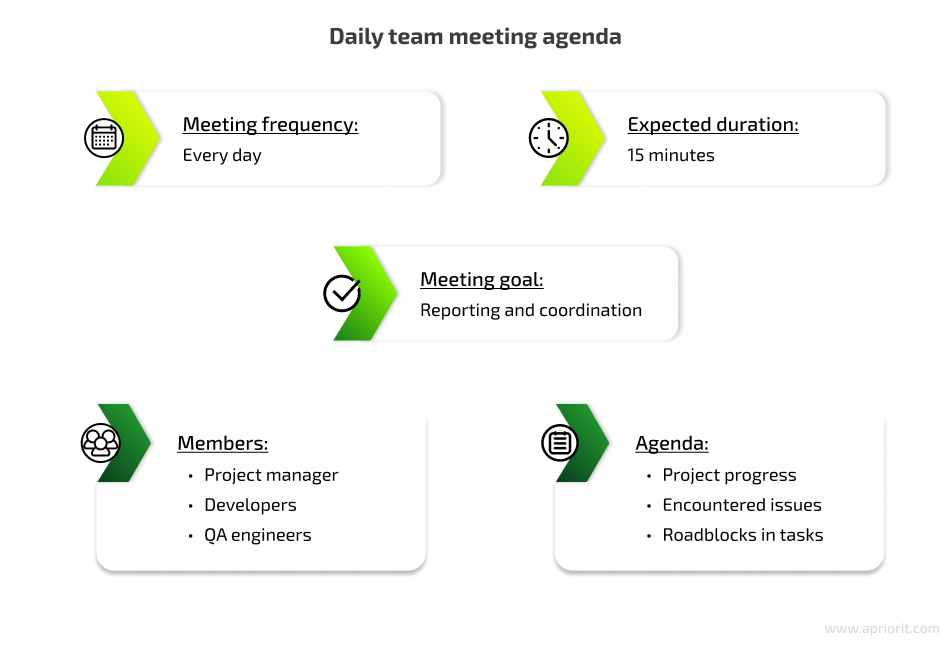
Benefits: Daily stand-up meetings offer several benefits to the project team.
- The team can share updates, ask questions, and identify potential issues.
- By sharing their daily progress and plans, team members are held accountable for their work and progress toward project goals.
- The team can notice potential problems early on.
Attendees: Project team, including the project manager, developers, and QA engineers. The client is welcome to attend such meetings, but their presence isn’t necessary.
Agenda: A daily stand-up typically includes three questions that each team member answers:
- What did you do yesterday?
- What are you planning to do today?
- Are there any roadblocks in your tasks?
The project manager has to keep a stand-up meeting time-bound and focused on the agenda. A development team can often start technical discussions during such meetings, and it’s the PM’s duty to recognize whether the team can discuss their issues during the stand-up or if they need a separate meeting.
The most common issue our PMs notice during stand-up meetings is when a team member is stuck with their tasks and doesn’t show any progress. A project manager should figure out the cause of productivity issues, identify blockers, and help team members get back on track.
During a stand-up meeting, Apriorit’s project managers also take notes on project progress and use this information to compile reports for our clients.
Read also
Outsourcing Project Management: Concerns, Advantages, and Our Approach
Discover how we address common concerns about working with outsourced PMs and help our clients get professional services and save project resources.

Planning meeting
A planning meeting is a part of project communication management held at the beginning of each sprint to define the scope of the sprint and discuss how the team will achieve the sprint goals. Such meetings typically take four hours for a two-week sprint and are adjusted for longer and shorter sprints. As a result of the planning meeting, the project manager can create a planning report and share it with stakeholders as another sprint artifact.
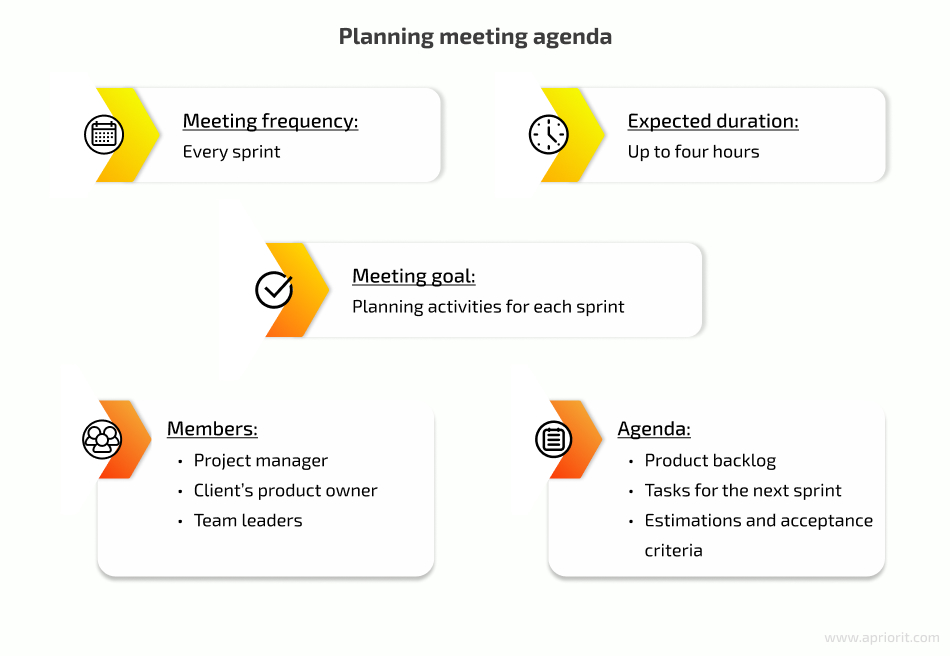
Benefits:
- Ensures team alignment with project objectives
- Provides a clear understanding of work to be completed
- Helps the team adjust plans if necessary
- Focuses the team on delivering value to the customer
Attendees: The entire project’s Agile team, including the product owner on the client’s side. Involving a lot of people in planning allows a project manager to discuss and set project priorities for a sprint.
Agenda: During the planning meeting, the team usually:
- Reviews the product backlog
- Prioritizes tasks based on their business value and development needs
- Defines acceptance criteria for each task
- Estimates each planned task
Planning meetings help project managers keep track of project progress, client expectations, and sprint plans. Such meetings also help to motivate developers, show them their progress with the project, and keep a consistent level of performance.
During a planning meeting, Apriorit’s project managers always balance the work to be done and the team’s capacity for a sprint. They also compare plans for the previous sprint with actual progress. If there’s a big gap, it can indicate issues with team performance or the planning process.
Retrospective
The purpose of the retrospective meeting is to reflect on the project’s processes, successes, challenges, and opportunities for improvement. It’s a space for each team member to speak, discuss issues, generate ideas, etc.
At Apriorit, we usually conduct a retrospective meeting at the end of each iteration. For Agile projects, it’s at the end of each sprint, and for Kanban and Waterfall projects, at the end of a project phase or once per month. A retrospective typically takes one to two hours.
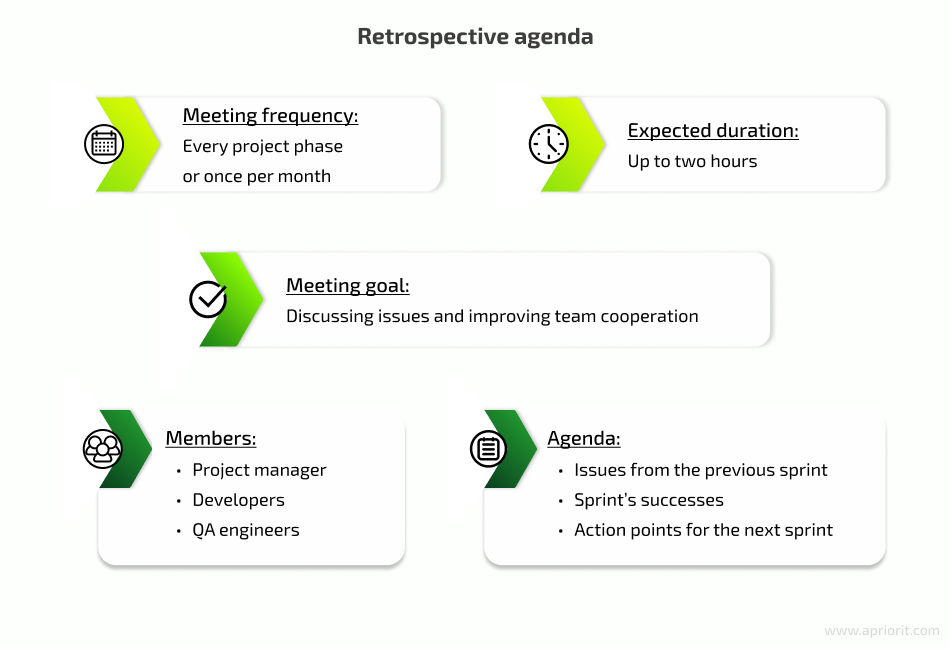
Benefits:
- Continuous improvement. By discussing previous iterations, the team can improve its processes and find ways to work more efficiently.
- Transparent and honest communication. When team members have an opportunity to talk about their experiences and issues on the project, they can build healthy communication inside the team and reduce the number of hidden risks and issues.
- Efficient resource use. The team can make changes to its processes, communication, and behavior that can lead to more efficient use of time, money, and other resources.
Attendees: The entire development team participates in the retrospective meeting. The client’s stakeholders are also welcome to join if they want to share their feedback with the team or help resolve issues.
Agenda: During the retrospective meeting, the team discusses:
- The to-do list from the previous retrospective
- What went well during the iteration
- What didn’t go well
- Action points
Apriorit PMs adjust retrospective meetings to the needs of a particular team and project communication management. For a new team early in the project, it’s crucial to have regular retrospective meetings where all team members discuss current issues and ways to resolve them. It’s also useful to try different games during retrospectives to break the ice and help everyone share their thoughts. On the other hand, team members who work together for a long time on the same project may not need regular retrospective meetings.
One-on-one meeting
One-on-one meetings are typically conversations between a PM or a team leader and a team member. At Apriorit, one-on-one meetings are an essential tool to support the growth of our team members. These meetings focus on an individual’s goals, education, and progress, as well as ways for the PM to offer support.
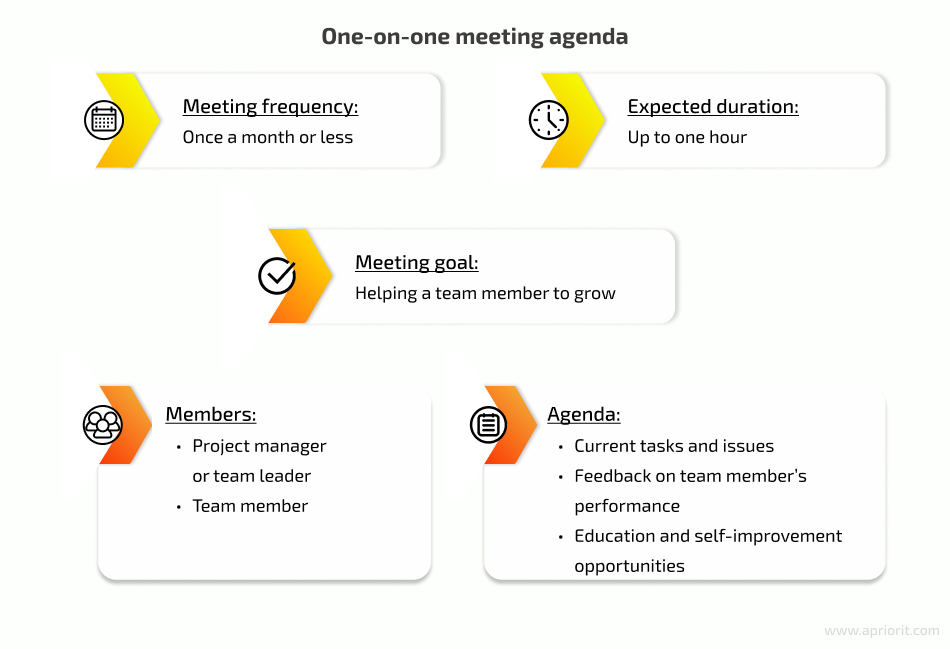
Benefits:
- Enhanced professional relationships
- Opportunities for growth of team members
- Increased satisfaction and retention inside the team
- Early identification of issues and challenges that can be addressed quickly
Attendees: A PM and a team member
Agenda: Topics for one-on-one meetings always depend on the participants. The PM creates an agenda depending on the previous topics, the mentee’s goals, feedback on the mentee’s work, etc. A typical agenda includes:
- Updates on current projects and priorities
- Сhallenges or roadblocks the mentee is facing
- Feedback on performance and areas for improvement
- Opportunities for growth and education
Conducting regular one-on-one meetings helps our PMs detect when a team member wants to resign from the current project and help them resolve their issues. Also, the PM can help a team member plan their growth and set education plans.
Key reports for project communication management
Reports are an essential tool for building communication between a PM and external stakeholders. They help to keep track of progress, identify potential issues, and ensure that the project is meeting its goals and objectives. Reports also managing project communication in an efficient manner save the client’s time, as the client doesn’t need to invite stakeholders to project meetings and can simply send an email instead.
At Apriorit, we regularly share two types of reports with our clients: project status and performance reports. They help us establish efficient project communication management. Let’s examine them.
Read also
Project Management Audit: Why It’s Important and How to Conduct One [Practical Example]
Learn how a timely project management audit can help you discover hidden issues, save project resources, and improve the development process.

Status report
This is the most common type of report we use on each project. It helps to track project updates on a regular basis.
A status report contains information like:
- A high-level overview of the team’s progress during the iteration, current roadblocks, and plans
- Detailed reports from developers
- Metrics after the previous iteration (if any exist)
- Questions from the team to the client
Benefits:
- Transparency between all project stakeholders
- Retrospective log of the project’s flow, results, and issues
- Ability to proactively respond to current project issues
Format: An email with varying frequency. Depending on the size of a team, the nature of the project, and stakeholders’ preferences, a PM can send such a report weekly, bi-weekly, or monthly.
Recipients: The PM can share the report with all stakeholders and team members to keep everyone on the same page about the latest news, changes, and plans.
Project performance report
At Apriorit, we use Earned Value Analysis (EVA) for any project with a declared scope. EVA is a project management tool that measures the amount of work planned versus the amount of work actually performed within a project’s budget and time constraints. This tool allows project managers to forecast a project’s total cost and schedule based on trends and burn rate.
The report includes several key performance indicators:
- Schedule variance
- Cost variance
- Schedule performance index
- Cost performance index
- PM’s description of the project’s current status, bottlenecks, risks, and action points
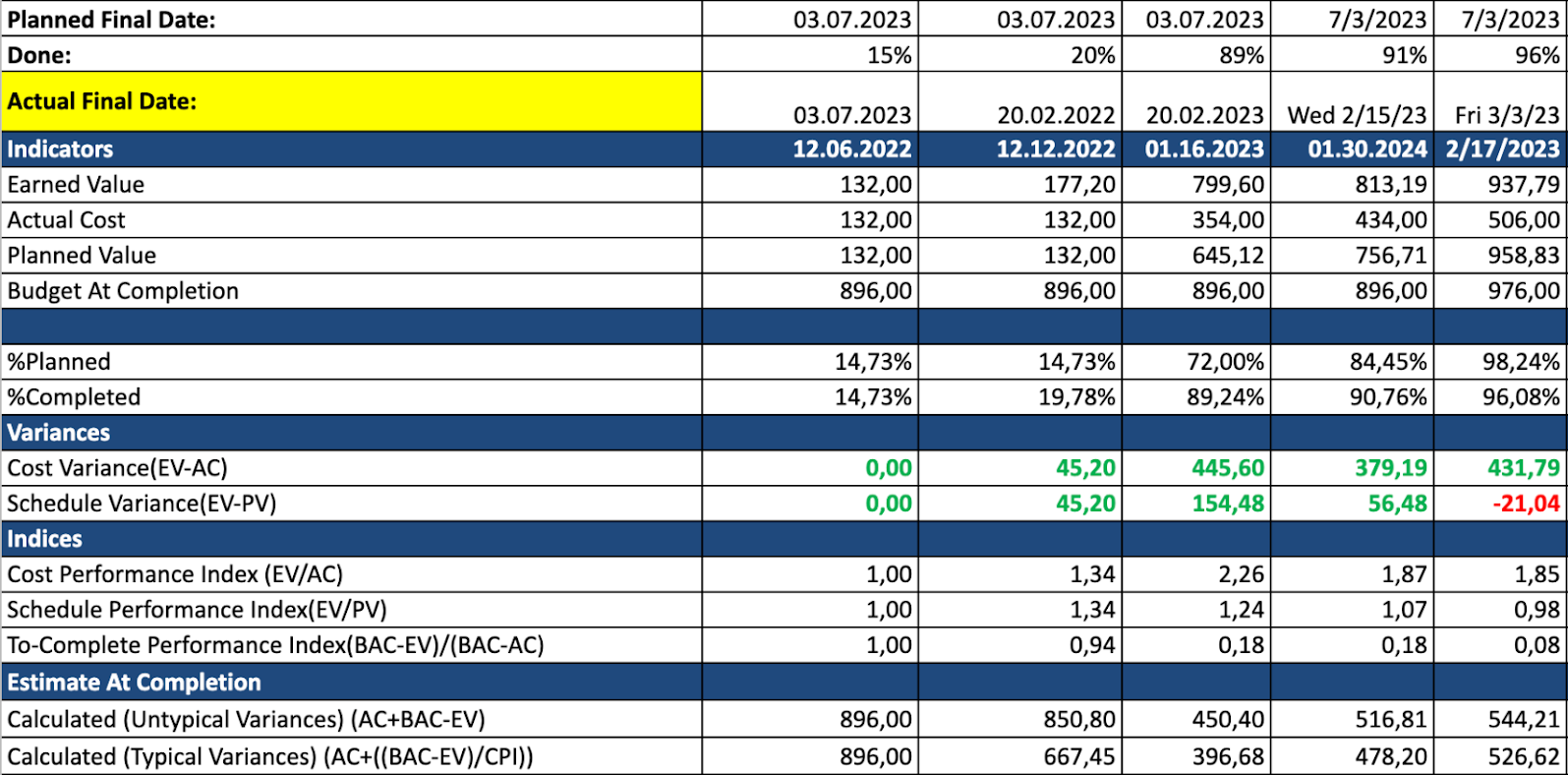
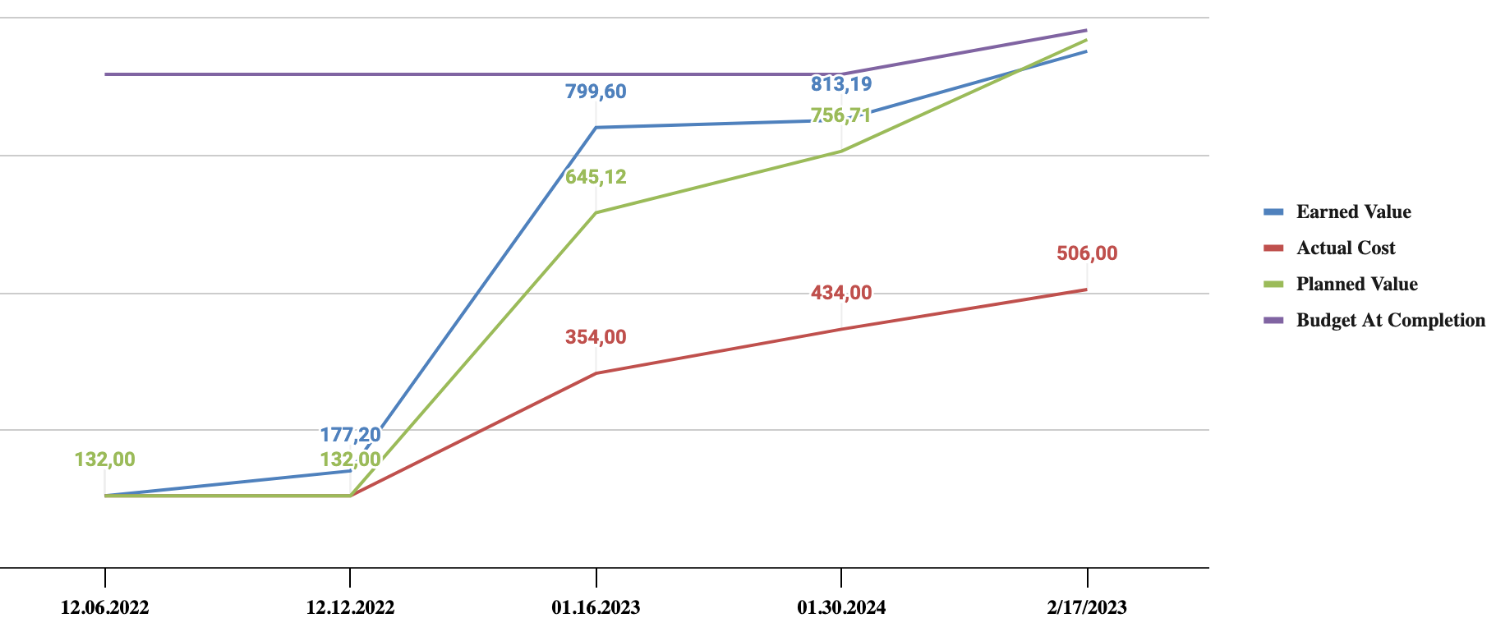
Benefits:
- Accurate and realistic measurements of project progress
- Early identification of cost overruns, schedule delays, and performance issues
- Continuous improvement of project performance
Recipients: All stakeholders who are responsible for the budget and time management. The PM sends a project performance report with an EVA by email or presents it during a meeting. The frequency of such reporting depends on the project’s stage. At Apriorit, we mostly calculate EVA once per sprint or iteration.
Conclusion
Efficient project communication management processes help a project team interact in a way that enables them to reach their goals, detect and resolve issues early, and improve the quality of their collaboration. It also helps a client to keep track of their project’s progress and get insights for making informed decisions.
To establish efficient communication, Apriorit’s project managers adjust the meetings and reports they use to the needs of a particular project and team. This way, PMs facilitate information sharing and keep everyone on the same page without wasting time on unnecessary discussions.
Striving for professional project management?
Apriorit experts can help you boost the intelligence of your business by implementing cutting-edge AI technologies. We provide AI development services to companies in various industries, from healthcare and education to cybersecurity and remote sensing.




